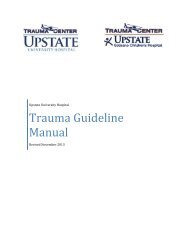10 Alumni Journal - SUNY Upstate Medical University
10 Alumni Journal - SUNY Upstate Medical University
10 Alumni Journal - SUNY Upstate Medical University
Create successful ePaper yourself
Turn your PDF publications into a flip-book with our unique Google optimized e-Paper software.
helping haiti<br />
the world turned its attention to Haiti<br />
in mid-January after news that a 7.0<br />
earthquake had inflicted mass destruction and<br />
loss of life on capital-city Port au Prince. The<br />
disaster had particular significance for five<br />
<strong>Upstate</strong> <strong>Medical</strong> students—three of whom<br />
are natives of the country—who had just<br />
returned from a two-week medical mission<br />
in Haiti a week earlier.<br />
Although communication was difficult,<br />
Claudy Zulme ’13, Farah Daccueil ’12 and<br />
Marvinia Charles ’12 would soon confirm<br />
that family members were alive (including<br />
Zulme’s wife and children), although all<br />
had lost homes. Loved ones had either fled<br />
to other family in neighboring areas or, like<br />
most residents of Port au Prince, were living<br />
on the streets. “Even if the homes are still<br />
partially standing, it’s recommended by both<br />
the Haitian and American government not<br />
to go back inside because they may not be<br />
stable,” says Charles.<br />
The three Haitian natives, along with<br />
classmates Nathaniel Herr ’12 and Brian<br />
Buckley ’12, spent two weeks over the<br />
December break working in and witnessing<br />
some of Haiti’s most desperate and shortsupplied<br />
conditions.<br />
The trip germinated in early fall, spurred<br />
by the summer experiences of Zulme, who’d<br />
spent part of his summer in Port au Prince<br />
volunteering at the General Hospital, efforts<br />
to give back to a country whose medical<br />
system he viewed as in great decline. A<br />
native of the country, Zulme moved to the<br />
United States at age 20 and came to medical<br />
school after three years in the U.S. Navy.<br />
Over the next several months, four classmates<br />
signed on to join him in a medical<br />
mission over the holiday vacation. They<br />
delivered much-needed medical supplies to<br />
s t u d e n t r o u n d s<br />
Five medical students spent two weeks on a medical mission in haiti.<br />
A week after their return, the earthquake hit.<br />
Nate Herr ’12 and Claudy Zulme ’13 learn the framework for clinically assessing patients and making<br />
rational therapy choices given the limited resources available.<br />
the General Hospital in Port au Prince and a<br />
smaller clinic in Zulme’s home village, where<br />
they also were able to observe and assist the<br />
medical professionals, and visited some of<br />
the countries many orphanages.<br />
These experiences provided a unique<br />
perspective to understand how the earthquake<br />
has overwhelmed an already fragile<br />
healthcare system, where at the best of times,<br />
supplies are low or non-existent, and there<br />
is no ambulance service, fire department or<br />
disaster care. The following are excerpts from<br />
writings Herr made during and after the trip:<br />
general hospital<br />
We’ve been staying at an apartment on the<br />
mountainside overlooking Port-au-Prince.<br />
Some doctors at the public hospital have<br />
been gracious enough to let us round with<br />
them this week and see some serious, dire,<br />
and desperate states of health. For example,<br />
at the public hospital your bed and physician<br />
consult is free. The beds are random, come<br />
with or without sheets, and are packed into<br />
an open-air hall. Health-care professionals,<br />
about three or four per hall, do their best to<br />
round to the patients, examine, and move<br />
the treatment to the next step. If a procedure<br />
or test is needed, it is the patient’s or<br />
their family’s responsibility to go and get<br />
the x-ray, lab results, medication or casting<br />
material from a pharmacy or lab across the<br />
street. There just isn’t the infrastructure or<br />
human resources to provide the connections.<br />
Everything medical is bigger here. People<br />
tend to wait until the very last minute to seek<br />
14 A l U M n i J o U r n A l / s P r i n g 2 0 1 0

















